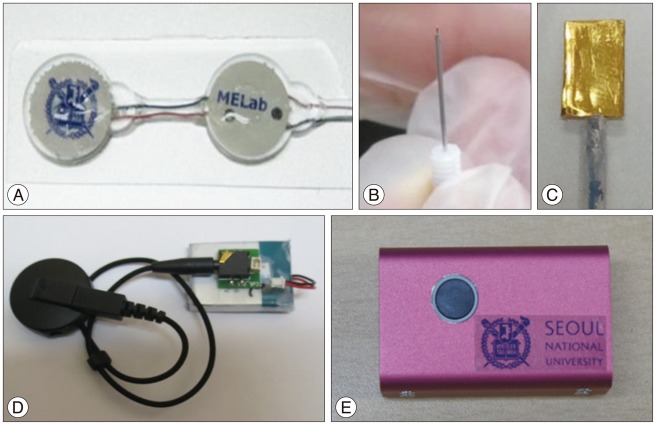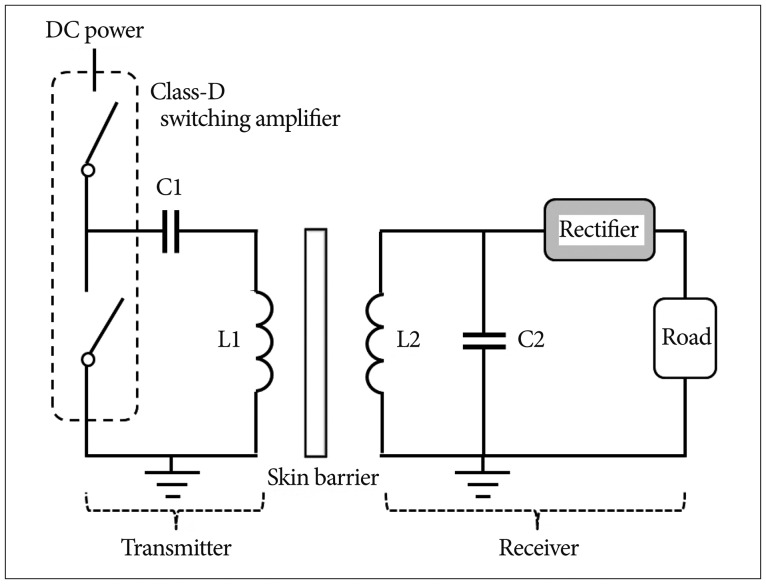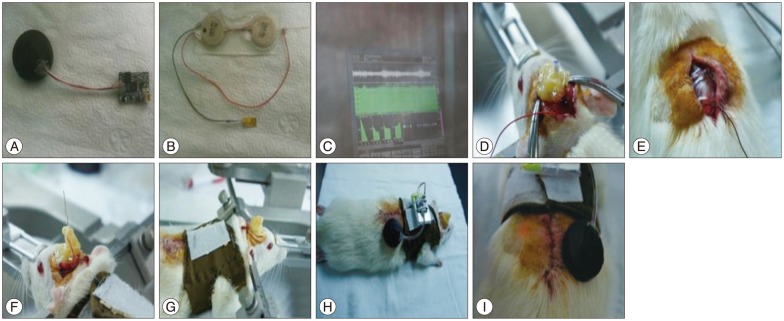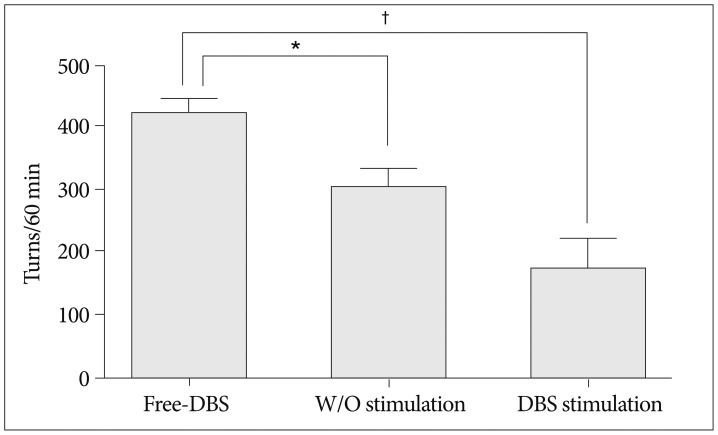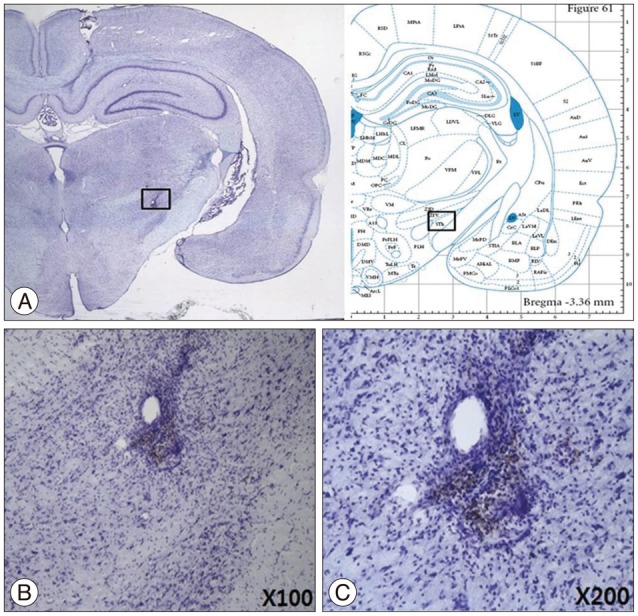J Korean Neurosurg Soc.
2015 Mar;57(3):152-158. 10.3340/jkns.2015.57.3.152.
Fully Implantable Deep Brain Stimulation System with Wireless Power Transmission for Long-term Use in Rodent Models of Parkinson's Disease
- Affiliations
-
- 1Interdisciplinary Program, Bioengineering Major, Graduate School, Seoul National University, Seoul, Korea.
- 2Department of Biomedical Engineering, College of Medicine and Institute of Medical & Biological Engineering, Medical Research Center, Seoul National University, Seoul, Korea.
- 3Department of Neurosurgery, Seoul National University Hospital, Seoul, Korea. paeksh@snu.ac.kr
- KMID: 2191214
- DOI: http://doi.org/10.3340/jkns.2015.57.3.152
Abstract
OBJECTIVE
The purpose of this study to develop new deep-brain stimulation system for long-term use in animals, in order to develop a variety of neural prostheses.
METHODS
Our system has two distinguished features, which are the fully implanted system having wearable wireless power transfer and ability to change the parameter of stimulus parameter. It is useful for obtaining a variety of data from a long-term experiment.
RESULTS
To validate our system, we performed pre-clinical test in Parkinson's disease-rat models for 4 weeks. Through the in vivo test, we observed the possibility of not only long-term implantation and stability, but also free movement of animals. We confirmed that the electrical stimulation neither caused any side effect nor damaged the electrodes.
CONCLUSION
We proved possibility of our system to conduct the long-term pre-clinical test in variety of parameter, which is available for development of neural prostheses.
MeSH Terms
Figure
Reference
-
1. Awan NR, Lozano A, Hamani C. Deep brain stimulation : current and future perspectives. Neurosurg Focus. 2009; 27:E2. PMID: 19569890.2. Baunez C. A few examples of the contribution of animal research in rodents for clinical application of deep brain stimulation. Prog Brain Res. 2011; 194:105–116. PMID: 21867798.
Article3. Benabid AL, Benazzouz A, Hoffmann D, Limousin P, Krack P, Pollak P. Long-term electrical inhibition of deep brain targets in movement disorders. Mov Disord. 1998; 13 Suppl 3:119–125. PMID: 9827607.
Article4. Canterbury RJ. Deep brain stimulation for obsessive-compulsive disorder. J Neurosurg. 2003; 98:941–942. discussion 942. PMID: 12744349.
Article5. Duong TP, Lee JW. Experimental results of high-efficiency resonant coupling wireless power transfer using a variable coupling method. IEEE Microw Wirel Compon Lett. 2011; 21:442–444.
Article6. Fotopoulou K, Flynn BW. Wireless power transfer in loosely coupled links : coil misalignment model. IEEE Trans Magn. 2011; 47:416–430.
Article7. Hamani C, Nobrega JN, Lozano AM. Deep brain stimulation in clinical practice and in animal models. Clin Pharmacol Ther. 2010; 88:559–562. PMID: 20720537.
Article8. Liang CK, Chen JJ, Chung CL, Cheng CL, Wang CC. An implantable bi-directional wireless transmission system for transcutaneous biological signal recording. Physiol Meas. 2005; 26:83–97. PMID: 15742881.
Article9. Millard RE, Shepherd RK. A fully implantable stimulator for use in small laboratory animals. J Neurosci Methods. 2007; 166:168–177. PMID: 17897719.
Article10. Morrison CE, Borod JC, Brin MF, Raskin SA, Germano IM, Weisz DJ, et al. A program for neuropsychological investigation of deep brain stimulation (PNIDBS) in movement disorder patients : development, feasibility, and preliminary data. Neuropsychiatry Neuropsychol Behav Neurol. 2000; 13:204–219. PMID: 10910093.11. Ng DC, Tamura H, Mizuno T, Tokuda T, Nunoshita M, Ishikawa Y, et al. An implantable and fully-integrated complementary metal-oxide semiconductor device for in vivo neural imaging and electrical interfacing with the mouse hippocampus. Sens Actuators A Phys. 2008; 145:176–186.12. Qian X, Hao HW, Ma BZ, Wen XW, Hu CH, Li LM, et al. Programmable and implantable neurostimulator with novel stimulus waveforms for rat models. Electronics letters. 2012; 48:1035–1036.
Article13. Vandevoorde G, Puers R. Wireless energy transfer for stand-alone systems : a comparison between low and high power applicability. Sens Actuators A Phys. 2001; 92:305–311.
Article
- Full Text Links
- Actions
-
Cited
- CITED
-
- Close
- Share
- Similar articles
-
- Levodopa-induced respiratory dysfunction in Parkinson’s disease managed with subthalamic nucleus deep brain stimulation
- Update on Current Technologies for Deep Brain Stimulation in Parkinson’s Disease
- Implantable Bio-sensor Research for Administration of Chronic Disease
- Surgical Treatment of Advanced Parkinson Disease
- In vivo Performance Evaluation of Implantable Wireless Neural Signal Transmission System for Brain Machine Interface

